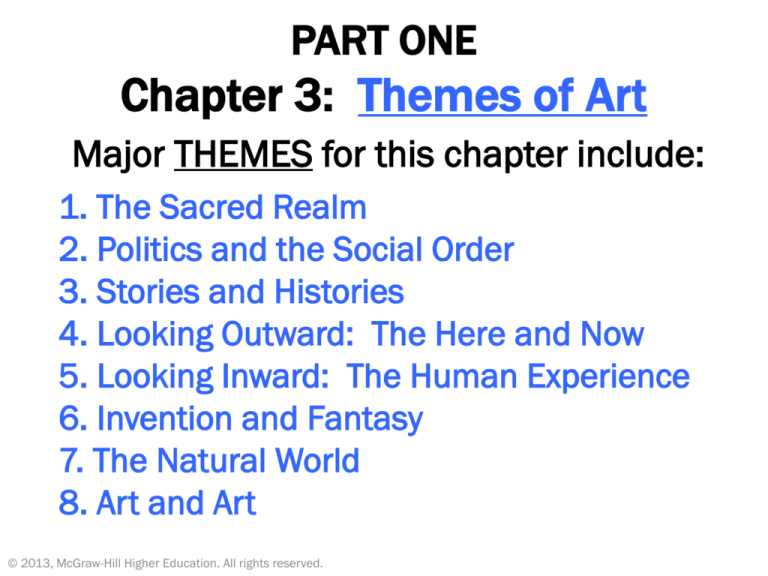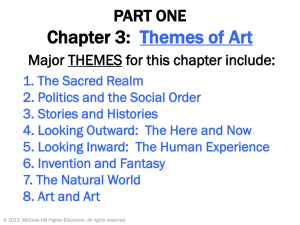
PART ONE
Chapter 3: Themes of Art
Major THEMES for this chapter include:
1. The Sacred Realm
2. Politics and the Social Order
3. Stories and Histories
4. Looking Outward: The Here and Now
5. Looking Inward: The Human Experience
6. Invention and Fantasy
7. The Natural World
8. Art and Art
© 2013, McGraw-Hill Higher Education. All rights reserved.
Key Terms for this chapter include:
• space cells
• iconoclasm
© 2013, McGraw-Hill Higher Education. All rights reserved.
Themes of Art
• Themes and purposes may differ
within a work of art.
• A work of art may reflect more than
one theme.
© 2013, McGraw-Hill Higher Education. All rights reserved.
Themes of Art
Our modern world of art includes schools,
galleries, critics, collectors and museums.
It features individual artists working
independently expressing their own ideas.
In the past, an artist typically worked for a
client, patron, or collaboratively in a
workshop. Rarely were individual artists
known.
© 2013, McGraw-Hill Higher Education. All rights reserved.
The Sacred Realm
The sacred realm cannot be seen with
human eyes. Religious images help to
give concrete form to abstract ideas.
• Iconoclasm: Derived from the Greek word
meaning “image breaking” and refers to
the destruction of images in the name of
spiritual purity.
© 2013, McGraw-Hill Higher Education. All rights reserved.
Upper Chapel, Sainte-Chapelle,
Paris, 1243-48
Prayer Hall of Great Mosque,
Spain, Begun 786 c.e.
Madonna Enthroned, Cimabue,
1280-1290
Early Christian art
Use overlap to create space.
Prominence through size and
placement. Baby Christ has adultfeatures but small. Tempera on
wood
Politics and the Social Order
Political art and social statements
are often intertwined and reflect
the nature of a society.
© 2013, McGraw-Hill Higher Education. All rights reserved.
The Great Pyramids, Giza, Egypt,
2500 BC
Liberty Leading the People, Delacroix,
1830
Guernica, Picasso, 1937
25’ x12’
Cubism,
Stories and Histories
Artists sometime use stories as subject
matter to express cultural history or
shared experiences.
• Space cells: An area within a work of art
referred to as “painting within a painting”
used for visual narration of a story.
© 2013, McGraw-Hill Higher Education. All rights reserved.
3.10 Rama and Lakshmana Bound by Arrow-snakes,
Sahibdin and workshop, 1650-52
Altar to the Chases High School,
Christian Boltanski, 1987
Looking Outward: The Here and Now
This theme illustrates artwork dealing
with the everyday, here and now, and
often makes use of images that are
part of the artists’ everyday lives.
The artists’ visual concerns are often
close to their personal world.
© 2013, McGraw-Hill Higher Education. All rights reserved.
The highway apparently ends here, disappearing into the
woods - not a promising location for a gas station. The last
car seems to have passed long ago; the attendant is
shutting down the pump, and soon will turn off the lights
and lock up for the night.
Hopper's painting represents a borderline situation. It is set
at the frontier between day and night, between civilization
and nature. The gas station has the appearance of a last
outpost, where the human realm gives way, across the
road, to the anonymous realm of nature. the edge of the
woods rises like a dark wall in which no individual tree can
be discerned. But our eye returns again and again to its
warm hue. The bright, almost pure white fluorescent light in
the gas station, in contrast, is almost painful to look at, and
the eye shifts to the ribbon of road leading out of the
picture to the right.
Gas, Edward Hopper, 1940
American Scene Painter
Windward, Robert Rauschenberg,
1963
Felt daily life could not be
depicted with one image
and treated canvas like
scrapbook page.
Controlled chaos and free
association
Looking Inward: The Human Experience
This theme addresses what it is like
to be human and questions that
many humans ask like “Who am I?”.
© 2013, McGraw-Hill Higher Education. All rights reserved.
Talking Skull, Meta Warrick Fuller, 1937.
Self-Portrait with Monkeys, Frida
Kahlo, 1943.
Woman Holding a Balance,
Johannes Vermeer, 1664
Invention and Fantasy
Art that springs from the imagination
is represented through the theme of
invention and fantasy. It is the
product of dreams, fantasy, and
daydreaming.
© 2013, McGraw-Hill Higher Education. All rights reserved.
The Garden of Earthly Delights,
Hieronymous Bosch, 1490
Triptych- 3 part painting,
middle part shown.
Other 2 sides can close
and are painted on both
sides.
Closed= creation.
Open (Left panel =Eden,
middle=garden of
earthly delights or false
paradise of love, and
right panel =Hell).
The Dream, Henri Rousseau,
1910
Empty Dream, Mariko Mori,
4’x10’, 1995
The Natural World
This theme deals with our relationship
to nature and the artist’s use of it as
subject matter. Some artists simply
represent nature and others use it as
a vehicle to explore other ideas.
© 2013, McGraw-Hill Higher Education. All rights reserved.
The Oxbow , Thomas Cole, 1836.
White Clouds over Xiao and Xiang,Wang Jian,
1668
Landscape is most honored
subject of Chinese. Not
observed, but imaginary.
Bird’s eye view unlike Cole’s
landscape which makes us
perched on hill looking down.
Spiral Jetty, Robert Smithson,
1970
Art and Art
This theme explores the use of art
being pursued for its own sake.
Artists learn to make art by looking at
art.
© 2013, McGraw-Hill Higher Education. All rights reserved.
Erija in Suruga Province,
Hokusai, 1831
Sudden Gust of Wind
(after Hokusai, Jeff
Wall, 7.5’x12.5’, 1993
Six Colorful Inside Jobs, John Baldesarri, 1977.
Themes of Art: Summary
Major THEMES covered in this chapter:
1. The Sacred Realm
2. Politics and the Social Order
3. Stories and Histories
4. Looking Outward: The Here and Now
5. Looking Inward: The Human Experience
6. Invention and Fantasy
7. The Natural World
8. Art and Art
Key Terms: space cells, iconoclasm
© 2013, McGraw-Hill Higher Education. All rights reserved.







